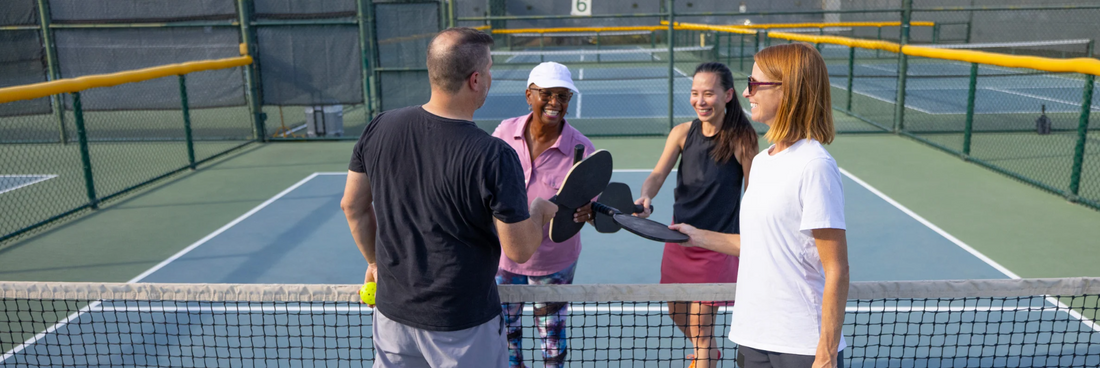
Seasonal Pickleball: Adjusting Your Game for Winter, Spring, Summer, and Fall
Share
Pickleball is a sport for all seasons, but the way you play, train, and even dress should adapt to the time of year. Each season introduces unique environmental challenges that influence ball speed, court traction, player stamina, and overall strategy. Understanding how to adjust your game for winter, spring, summer, and fall ensures that you stay competitive, comfortable, and safe throughout the year.
Winter: Precision Over Power
When temperatures drop, pickleballs tend to harden, making them bounce lower and travel faster. Outdoor courts can also become slick from frost or residual moisture.
Key Adjustments
- Shorten your warm-up: Spend extra time on dynamic stretching and mobility work to combat stiffness in cold muscles.
- Emphasize control: The faster, lower bounce means more emphasis on dinks and soft shots to keep rallies manageable.
- Layer smartly: Wear moisture-wicking base layers under warmer apparel to maintain mobility without overheating.
Pro Tip
Use indoor facilities when possible, as they provide consistent ball behavior and allow for uninterrupted training during unpredictable winter weather.
Spring: Embracing Unpredictability
Spring weather can be erratic, with gusts of wind, sudden showers, and fluctuating temperatures. The court surface may still carry winter wear, making footing slightly unstable.
Key Adjustments
- Train with the wind: Practice hitting with and against gusts to build shot adaptability.
- Focus on agility: Quick directional changes help you respond to erratic ball movement in windy conditions.
- Experiment with spin: Wind amplifies the effect of topspin and slice, making them potent weapons when used intentionally.
Pro Tip
Bring multiple layers and keep a towel in your gear bag—spring matches can start chilly and end warm.
Summer: Managing Heat and Endurance
High temperatures and intense sun can take a toll on your body and equipment. Heat can soften pickleballs, making them bounce higher and move slightly slower, which can extend rallies.
Key Adjustments
- Prioritize hydration: Begin hydrating hours before play, not just during breaks.
- Use breathable fabrics: Lightweight, UV-protective clothing keeps you cool while protecting your skin.
- Adapt your pacing: Conserve energy during long rallies and avoid unnecessary sprinting.
Pro Tip
Schedule matches in the early morning or late evening to avoid peak heat and reduce the risk of heat-related fatigue.
Fall: Transitioning for Consistency
Fall often brings mild temperatures but can feature damp courts from morning dew or early frost. The ball’s bounce can vary day to day as temperatures gradually drop.
Key Adjustments
- Refine timing: Cooler mornings can speed up the ball, while warmer afternoons may slow it down.
- Enhance footwork stability: Shoes with strong grip prevent slipping on damp surfaces.
- Shift strategy: As the air cools, harder shots may become more effective due to quicker ball speed.
Pro Tip
Use fall as a transitional season to fine-tune your game before winter indoor play. It’s an ideal time for skill-building and conditioning.
Conclusion
Playing pickleball year-round is not just about showing up—it’s about adapting your technique, equipment choices, and mindset to match the environment. By understanding seasonal effects on the ball, court, and your own body, you can stay consistent and competitive no matter the weather. The most successful players see the seasons not as obstacles but as opportunities to refine their adaptability and elevate their game.












